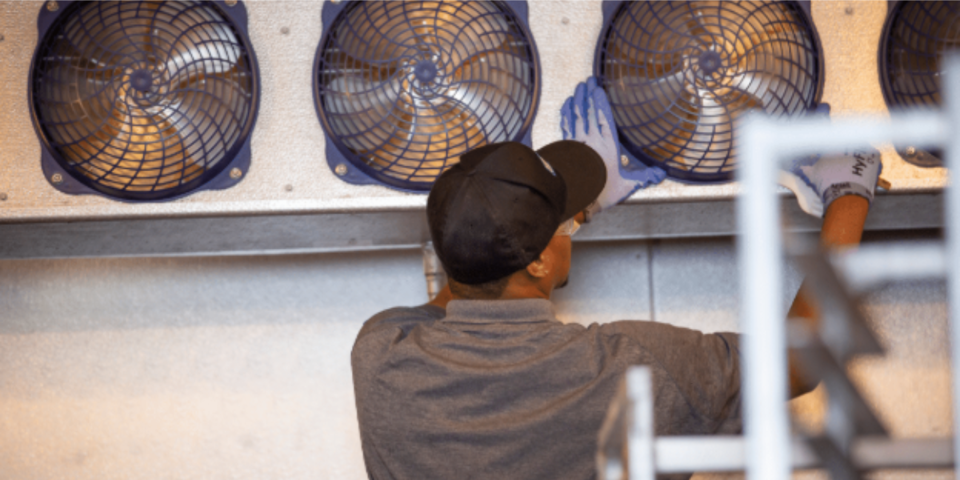Walk-in coolers are a staple in the food service, floral, medical, and hospitality industries. While insulation, door seals, and compressor efficiency are essential to overall performance, one critical element often overlooked is airflow. Effective air distribution inside a walk-in cooler isn’t just about keeping products cold—it’s about ensuring food safety, reducing energy waste, and maximizing the longevity of perishable items. Let’s dive into the science behind airflow design and why it should be a primary consideration for every walk-in cooler.
Why Airflow Matters
Proper airflow in walk-in coolers serves multiple purposes:
- Temperature Uniformity: Uneven air distribution leads to hot spots and cold zones, putting certain products at risk for spoilage or freezing.
- Food Safety Compliance: FDA and USDA regulations require specific temperature thresholds for stored goods. Poor airflow can jeopardize compliance.
- Energy Efficiency: Optimized airflow reduces the workload on evaporator coils and compressors, lowering energy bills.
- Moisture and Frost Control: Proper circulation prevents excessive humidity and frost buildup on coils and products.
Understanding Airflow Mechanics
Air in a walk-in cooler is typically circulated by one or more evaporator fans. These fans draw air over the evaporator coils, cooling it before distributing it throughout the space. The fundamental principle is to keep the air moving so that no stagnant pockets of warm air are allowed to develop.
However, the challenge arises when the layout of the cooler, the stacking of products, and the placement of the evaporator units are not strategically aligned. Without a design that considers airflow paths, even the best cooling equipment may underperform.
Key Elements of Airflow Planning
Evaporator Placement
The evaporator unit should be installed in a location that allows unrestricted air circulation. It should never be blocked by shelving or products. Typically, units are placed near the ceiling on one end of the cooler to allow cold air to flow down and across the entire storage area.
Air Deflectors and Ducts
Some walk-in coolers benefit from air deflectors or ductwork that guide airflow more precisely. These are particularly useful in large coolers or when obstructions (like tall shelves) might disrupt air patterns.
Return Air Pathways
Cool air must be able to return to the evaporator unit without obstruction. Inadequate return paths can cause uneven cooling and increased system strain. Return air should flow below and around shelving units back toward the intake side of the evaporator.
Product Placement
Too often, staff unknowingly block vents or stack items too close to the evaporator. A good rule of thumb is to leave at least 6 inches of space around all air vents and ensure no products are directly beneath the evaporator’s airflow path where they might freeze.
Shelving Design
Wire shelving is ideal because it allows air to pass through. Solid shelving disrupts airflow and can create localized temperature variances. Adjustable shelving also makes it easier to maintain airflow paths as inventory needs change.
The Role of Air Velocity and Volume
Not only does air need to circulate, but it must do so at the right speed and volume. Too much velocity can dry out produce or cause product packaging to shift. Too little, and air won’t reach all corners of the cooler.
This balance is typically achieved by calculating the correct CFM (Cubic Feet per Minute) rating for the evaporator fans, based on the size and configuration of the cooler. Professionals also consider BTU loads, insulation quality, and door usage frequency when determining airflow needs.
Common Airflow Mistakes to Avoid
- Overloading the Cooler: Overstocking disrupts airflow and puts strain on the refrigeration system.
- Neglecting Maintenance: Dirty coils and failing fans reduce airflow efficiency.
- Inadequate Spacing: Crowding products too close to walls or evaporators obstructs circulation.
- Ignoring Door Usage: Frequently opened doors increase heat load. Strip curtains and automatic door closers help minimize this impact.
Monitoring and Adjusting Airflow
Even with a well-designed system, conditions inside a walk-in cooler can change. That’s why ongoing monitoring is essential. Use data loggers or digital thermometers to spot inconsistencies. If you notice certain areas warming more quickly or showing signs of frost, airflow may need to be recalibrated.
Temperature mapping—placing sensors throughout the cooler to track variations—is a useful tool. It can guide adjustments in shelving layout, product placement, or fan settings to restore balance.
Smart Controls and Sensors
Modern walk-in coolers can be equipped with intelligent control systems that automatically regulate fan speeds, defrost cycles, and temperature targets. Some systems even include airflow sensors that alert staff if circulation drops below optimal thresholds.
Integrating these tools helps:
- Reduce energy waste
- Extend equipment lifespan
- Maintain tighter control over food safety parameters
Custom Airflow Design for Specialty Applications
Different industries and use cases demand unique airflow considerations:
- Restaurants & Food Service: Avoiding cross-contamination and ensuring uniform cooling for a variety of perishables.
- Breweries: Maintaining consistent temperatures during fermentation and storage.
- Florists: Gentle airflow that prevents petal damage and dehydration.
- Pharmaceutical Storage: Strict uniformity for regulatory compliance.
Working with a refrigeration expert ensures that your airflow design matches your business’s specific requirements.
Energy-Saving Benefits of Optimized Airflow
A well-balanced airflow system isn’t just good for product preservation—it also significantly reduces energy consumption. By preventing the over-cycling of compressors and maintaining even temperatures, optimized systems:
- Reduce compressor wear and tear
- Lower utility bills
- Minimize defrost frequency
- Shorten run times for evaporator fans
In the long run, proper airflow design pays for itself through operational savings and fewer emergency service calls.
Call the Experts in Commercial Refrigeration
Airflow might be invisible, but its impact on your walk-in cooler is undeniable. Whether you’re building a new system or troubleshooting issues in an existing one, R & R Refrigeration is here to help. Our experienced team designs and services walk-in coolers across the San Francisco Bay Area, ensuring optimal performance and compliance with safety standards.
Contact R & R Refrigeration today to schedule a walk-in cooler assessment or design consultation. Let us help you get cooled the right way.
FAQs About Walk-In Cooler Airflow
Ideally, leave at least 6 inches of space around the evaporator fan and any air vents. This ensures proper airflow and prevents freezing or blocked circulation.
Wire shelving is preferred because it allows air to flow through. Solid shelving can cause airflow disruption and temperature inconsistencies.
Signs include uneven temperatures, frost buildup on products or walls, and spoiled or frozen items. Using temperature sensors can help identify problem zones.
Absolutely. Poor airflow causes refrigeration systems to work harder, which leads to longer run times, higher energy use, and increased wear on components.
It’s a good idea to monitor airflow weekly and conduct a more thorough inspection monthly. Look for obstructions, dirty fans, and temperature inconsistencies.






